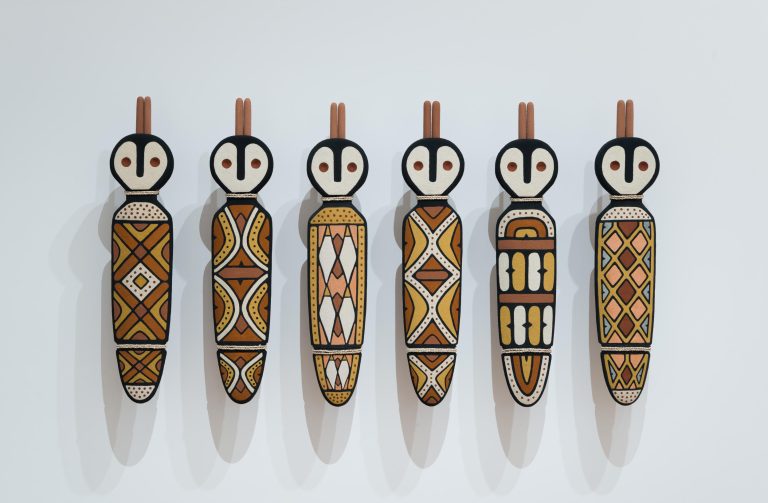We acknowledge the Traditional Owners of the land on which the Queensland Art Gallery | Gallery of Modern Art stands and recognise the creative contribution First Australians make to the art and culture of this country.
Michael Boiyool AnningYalma Nalan Gugal (Cross boomerang design firemaker); Yumun Nalan Gugal (Native banana design firemaker); Wanggulay Nalan Gugal (White cockatoo design firemaker); Bida Nalan Gugal (Bark dish design firemaker); Mugaru Nalan Gugal (Hand-held fish net design firemaker) unknown date
On Display: QAG, Gallery 10
Traditionally, all Nalan Gugal were carved and decorated in reverence for the ancestral or totemic being of the family group that carried them. Nalan Gugal translates literally to ‘board’ (Nalan) and ‘drill sticks’ (Gugal). Often the Nalan were carved in human form, sometimes representing the ancestral being who brought fire to the Earth, while others have been carved in the shape of animal totems.
“In traditional times the Gugal, drill sticks were placed into the eyes on the Nalan, main board, and after adding a small amount of charcoal, twirled rapidly to create friction. Some dry grass is then placed around the base, which eventually ignites, and is transferred to start the main fire in the camp.
The Nalan were often made from softwood such as the Sandpaper fig (‘Ficus coronata’) or Milky pine (‘Alstonia scholaris’), and the Gugal were made from the harder wood of the Tetra beech (‘Tetrasynandra laxiflora’). Usually, one man from the group had the responsibility of the camp fire and was not allowed to let it go out – the ‘spirit’ of the fire secured the camp.”
These works are considered ‘oversized’ Nalan Gugal, which are approximately four times the size of the standard firemakers Anning has become well-known for. The larger scale allows for greater resolution of the customary designs on the figure and an overall more imposing presence. The designs come from over 40 that Anning has revived and reinterpreted from customary designs found on historical Yidinyji shields. Each design has a specific story, with Anning providing the following statements of their stories:
Yalma: The design represents Cross boomerangs called Yalma. They were bound at the centre with natural fibre string and traditionally used by men in ceremonial dance. Decorated Yalma’s with totemic designs were twirled high up into the air during performances. Cross boomerangs were used by Yidinji, Gunggandji, Gulnay, Jirrbal and Girramay peoples. In traditional times men performed in a circle twirling them up into the air, and often twirled with a small hot coal on the ends to amuse children at night with fireworks.
Yumun: This design represents the ‘Yumun’ (‘Musa acuminata’ subsp. ‘banksia’ – native banana) which are native to North Queensland rainforests and edible bush food.
Wanggulay: ‘Wanggulay’ are the sulphur crested white cockatoos (‘Cacatua galerita’) found around north Queensland. The yellow feather on their head is called ‘Gula’. The ‘Gugaaji’ or call of a ‘Wanggulay’ sounds like someone is calling out a person’s name.
Bida: ‘Bida’ are small containers made by folding a leaf lengthwise and sewing each end to secure the shape. They are used for carrying food and would also be used by children as toy boats.
Mugaru: Butterfly-shaped nets called ‘Mugaru’ were used to trap fish in a waterhole. On occasion, crushed leaves from a ‘gilbajin’ (‘Jagera pseudorhus’) tree were placed into a ‘Bundu’ (bicornual basket) and positioned in the creek – the natural saponin from the leaves temporarily stunned the fish. They floated on the water and made them easier to catch. Nets were made by knotting natural fibre bush string together and attaching it to a lawyer cane frame. Usually, the bush string was twined from two strands of natural fibre from the bark of a fig tree. Other types of knotted nets were used to catch scrub-hens, scrub-turkeys and small wallabies.”
Michael Boiyool Anning was born in 1955 into the Yidindyji people, whose country includes the coastal plains around Cairns and extends up the Macalister Range (Kuranda Range) into the Atherton Tablelands. Anning is recognised as the foremost Indigenous artist in Queensland to revive the unique Bama customary art-making traditions such as Big-uun (shields) and Nalan Gugal (firemakers). Like his ancestors, Anning uses natural ochres and charcoal ash to apply decorations to his works but mixes it with a stabiliser such as PVA glue.
His language name, Boiyool, has two meanings: it is the word for a piece of lawyer cane cut specifically to stir a non-lethal quantity of poison into waterholes when hunting fish, and the name of a mythical being, half-human and half-eel, which travelled up the rivers and visited significant sites in the Dreaming.
